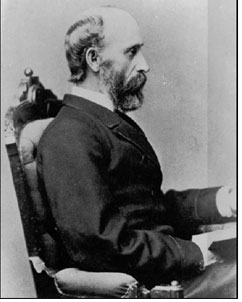Colonel
Theodore T.S. Laidley
 Theodore Thaddeus Sobieski
Laidley was born on April 14, 1822, in Guyandotte, Virginia (now West Virginia). Graduating from the United States
Military Academy in 1842, he chose a commission in the Ordnance Department. He then served in a series of
assignments as Assistant Ordnance Officer at the Watervliet Arsenal, New York; the Washington Arsenal, Washington,
DC; and the Allegheny Arsenal, Pennsylvania. With the outbreak of war with Mexico in 1846, Laidley joined MG
Winfield Scott's forces during the Veracruz Campaign, serving with the 60-man Ordnance detachment supporting
Scott's siege train and fought with distinction in the Battle of Cerro Gordo and the siege of Puebla, Mexico.
Theodore Thaddeus Sobieski
Laidley was born on April 14, 1822, in Guyandotte, Virginia (now West Virginia). Graduating from the United States
Military Academy in 1842, he chose a commission in the Ordnance Department. He then served in a series of
assignments as Assistant Ordnance Officer at the Watervliet Arsenal, New York; the Washington Arsenal, Washington,
DC; and the Allegheny Arsenal, Pennsylvania. With the outbreak of war with Mexico in 1846, Laidley joined MG
Winfield Scott's forces during the Veracruz Campaign, serving with the 60-man Ordnance detachment supporting
Scott's siege train and fought with distinction in the Battle of Cerro Gordo and the siege of Puebla, Mexico.
At war's end, Laidley returned to the United States to serve, from 1848 to 1854, as Assistant Ordnance Officer at the Watervliet and Fort Monroe, Virginia, arsenals, with brief duty as Commander of the Charleston Arsenal in South Carolina and later commanded the North Carolina Arsenal. In 1858, the Chief of Ordnance placed Laidley on detached service to write a new Ordnance manual. He labored until 1861 to prepare a 600-page, comprehensive manual that served as an essential guide for Ordnance officers during the Civil War.
With the outbreak of the Civil War, Laidley was appointed mustering officer for New Jersey. He successfully mustered the first nine New Jersey regiments into Federal service. In 1862, Laidley took command of the Frankford Arsenal in Philadelphia. Tasked to expand wartime production, he designed a new machine shop, laboratory, and rolling mill for the arsenal. In 1864, Laidley took command of the Springfield Armory and also served as the Inspector of Powder and chaired or served on a series of Ordnance boards testing an early machine gun, examining the potential of gun cotton, testing wrought-iron rifled cannon, and comparing the effectiveness of breech-loading rifles. Laidley not only tested weapons designed by others but invented his own, holding eight patents to include one for a rifle with an innovative rolling breechblock.
Laidley took command of the New York Arsenal, Governor's Island, New York, in 1866, overseeing the maintenance of the hundreds of guns and carriages comprising the New York harbor defenses. In 1871, he assumed his final command, the Watertown Arsenal in Massachusetts where he was responsible for the production of carriages, shot, and accessories for field, siege, and seacoast artillery.
While commanding Watertown Arsenal, Laidley busied himself with a host of additional duties. He served on a series of Ordnance boards, traveled to Europe to report on foreign Ordnance, and designed and built a lighter, more versatile traveling forge for the cavalry. In 1877, the Chief of Ordnance tasked Laidley to prepare a marksmanship manual. His A Course of Instruction in Rifle Firing, published in 1879, was the Army's first comprehensive marksmanship manual that included Laidley's own designs for a revolving target, a practice rifle, and aiming stand. His crowning achievement was the installation of the Emery Metal Testing Machine at Watertown Arsenal in 1879. Col. T.T.S. Laidley retired in 1882 after 40 years of service as an Ordnance Soldier and technologist.